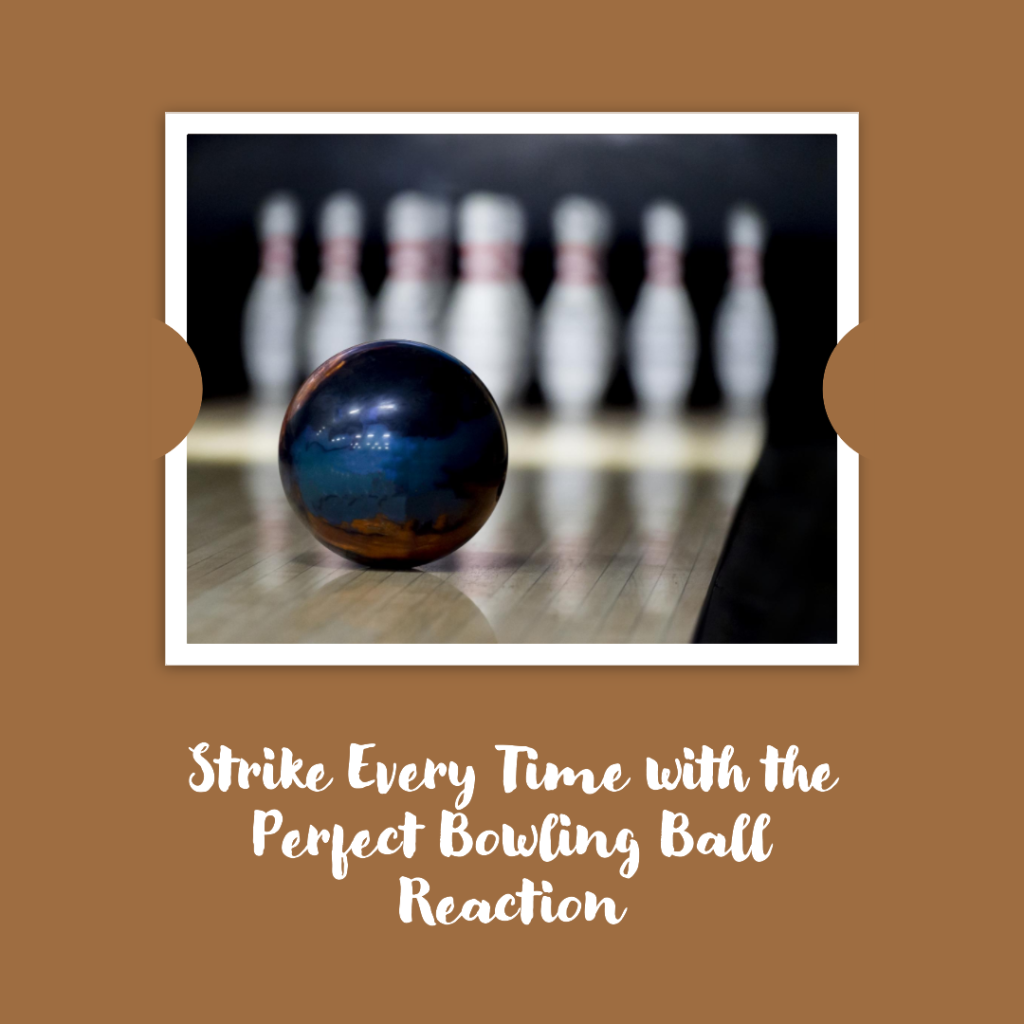In bowling, no equipment is more vital than the ball itself. The bowling ball is the key that unlocks a bowler’s full potential. Understanding the ball’s reaction as it travels down the lane is essential for maximizing performance.

The ball’s reaction, mainly determined by coverstock type, refers to its precise motion and curve toward the pins. Learning how coverstock materials like matte, shiny, pearl, and hybrid varieties influence reaction enables matching a ball to a bowler’s style.
Mastering bowling ball reactions helps you select the right ball for your game and knock down more pins. Let’s now know details about these Bowling reaction ball types.
What is the Bowling Ball Reaction?
The reaction of a bowling ball refers to how it moves when you roll it down the lane. Different balls are designed to react in different ways. The coverstock is the most significant factor affecting a bowling ball’s reaction. This is the material on the outside of the ball.
Coverstocks come in different types, like shiny, matte, or pearl. A matte coverstock will grip the lane more, so the ball hooks sooner. A polished coverstock doesn’t grip as much, so the ball goes straighter for longer before hooking. The reaction happens in two phases. First, the ball skids, and then it hooks toward the pins.
Understanding reactions can help you match a ball to your bowling style. If you throw straight, look for a ball with a shiny coverstock that skids more before hooking. Choose a ball with a matte coverstock if you want an earlier hook. With the proper reaction, you’ll knock down more pins.
What are the Bowling Ball Reaction Types?
When you roll a ball down the lane, it reacts in different ways. The reaction type is the shape of the curve it makes. There are four main reaction types for bowling balls. Learning about them helps you pick the right ball for you.
The way your ball moves matters. A straight line is different from a big hook. The reaction depends on things like the oil and ball material. Your technique also makes a difference in the curve.
Here are the four bowling ball reaction types:
Straight
A straight reaction means the ball travels directly down the lane with barely any curve or hook. This reaction is best for dry lane conditions when you want the ball straightened. Straight balls are made from polyester materials that don’t grip the lane as aggressively.
With minimal friction, they slide straight rather than curving. Successive balls are great for picking up spares because you can roll them directly at the remaining pins without worrying about the hook. They are predictable and accurate when you need a zero-hook ball.
Smooth
With a smooth reaction, the ball gradually arcs in a flowing curve down the lane. This type transitions slowly from skidding to hooking as it moves. Smooth reactions work well on lanes with medium to light oil conditions.
The ball will hook a little, but not sharply. Smooth reaction balls use urethane or reactive resin coverstocks that provide some traction for a controlled, sloped curve. This steady, rolling hook shape is forgiving and consistent. Smooth-rolling balls are ideal for targeting the pocket.
Sharp
A sharp reaction is when a ball suddenly hooks in a quick, abrupt curve. This type changes rapidly from skidding to hooking in a fast, angular move. Sharp reactions are best for heavy oil lane conditions.
The ball must push through a lot of oil before it can traction and whip around into a quick hook. Sharp reaction balls use reactive resin coverstocks that dig into the lane for this firm, aggressive hook. The strong move helps the ball find the pocket when oil pushes other balls out too far.
Angular
With an angular reaction, the ball hooks extremely fast and sharply, creating an exaggerated and exaggerated curve. This is the most aggressive hook reaction. Angular balls snap into a big hook very quickly after skidding.
They are made to cut through lots of oil or to throw from the far outside line. Angular reaction balls also use reactive resin to bite into the lane for strong backend hooks. The pronounced curve is excellent for striking when conditions limit hook potential.
Now you know the four main reaction types – straight, smooth, sharp, and angular. Each moves down the lane differently, from barely curving to aggressively hooking. The big question is, which type is right for you and your game?
Choosing the best reaction type depends on the lane oiling conditions and your bowling style. For dry lanes that don’t have much oil, go with a straight or smooth reaction that hooks less. Smooth and sharp reactions are ideal for a controlled hook when bowling on medium or lightly oiled lanes.
Pick a sharp or angular reactive ball for maximum hooking action for heavy oil conditions. Adjust your throwing technique, too.
Try changing your release if your ball hooks too much or not enough. Experiment with different reaction types and bowling on various lane patterns. This helps you learn which ball motions are best for achieving strikes and spares.
Bowling Ball Reaction Chart
The bowling ball reaction chart is an aid that will assist you in deciding which ball is ideal for playing. It illustrates various reactions, when they are effective, and all the variables that impact them. The chart’s quadrants depict four types of responses: early move, continual roll, late roll, & over/under.
Each quadrant is then subdivided into parts that depict the various parameters influencing the reaction, such as the ball’s weight, surface, and coverstock. Understanding the different reactions and the elements that affect them will allow you to select the ball that will give you the highest chance of success on the lanes.
The chart looks at things like:
- PAP Distance: The length from the bowler’s Positive Axis Point (PAP) to the pin is called the “axis distance.” The PAP is the spot where the fingers exit the ball. The axis distance is crucial because it affects the ball’s hook. A longer axis distance will cause the ball to hook more, while a shorter axis distance will cause the ball to hook less.
- Reaction Types: The ball’s curve shape, like straight, smooth arcing, sharply angled hook, or exaggerated hook.
- Break Point: The zone where the ball starts bending severely into the hook is called the hook zone. It is the area in front of the ball where the spin on the ball causes it to curve sharply.
- Hook Intensity: Hook intensity is the curve a ball makes as it travels down the lane. The bowler’s release point determines it, the angle of the bowler’s hand, and the amount of spin the bowler puts on the ball.
- Forward Roll: This bowling term refers to the continuous spin of the ball as it travels down the lane. The ball is given forward spin by the bowler applying pressure to the side of the ball with their fingers as they release it.
- Total Revolutions: The number of times a ball rotates around its axis while flying in the air. The higher the total revolutions, the more spin the ball has. Spin can affect the ball’s flight path and make hitting harder.
- Early and Late Revolutions: Spin rates before and after the ball hits the lane surface.
- Hook Measurement: Methods of quantifying the hook degree.
A bowler can make an intelligent ball decision to knock down more pins by recognizing these reactions and circumstances.
Conclusion
A thorough comprehension of the various bowling ball reactions is critical for selecting the appropriate ball and maximizing your scoring potential. Knowing the differences between straight, smooth, sharp, and angular reactions allows you to match your ball to the oil pattern on the lane.
Having the correct reaction also allows you to fine-tune your throwing technique. Experimenting with various reaction types also improves your versatility. Understanding ball motion makes you a better bowler. Mastering reactions will help you knock down more pins.

Passionate Bowler and Bowling Enthusiast
Jess Pinelli is a dedicated bowling enthusiast with a deep love for the sport that spans over 6 years. With numerous strikes, spares, and a few gutter balls under hes belt, he has honed his skills on lanes across the country. Pinelli’s journey in the world of bowling has been a remarkable one, from casual weekend games with friends to competitive league play and even a few local tournaments.
Driven by her passion for the game, Pinelli decided to channel her expertise and knowledge into the digital realm, becoming a prolific author on this bowling website. She’s your go-to source for everything bowling-related, from mastering the perfect hook to choosing the right bowling ball and even navigating the world of bowling etiquette.
When she’s not busy writing informative articles or reviewing the latest bowling gear, you’ll likely find Pinellis at her favorite local bowling alley, helping newcomers improve their game or enjoying some friendly competition with fellow bowlers. She firmly believes that bowling is not just a game but a community, and she’s committed to fostering that sense of camaraderie both online and offline.



